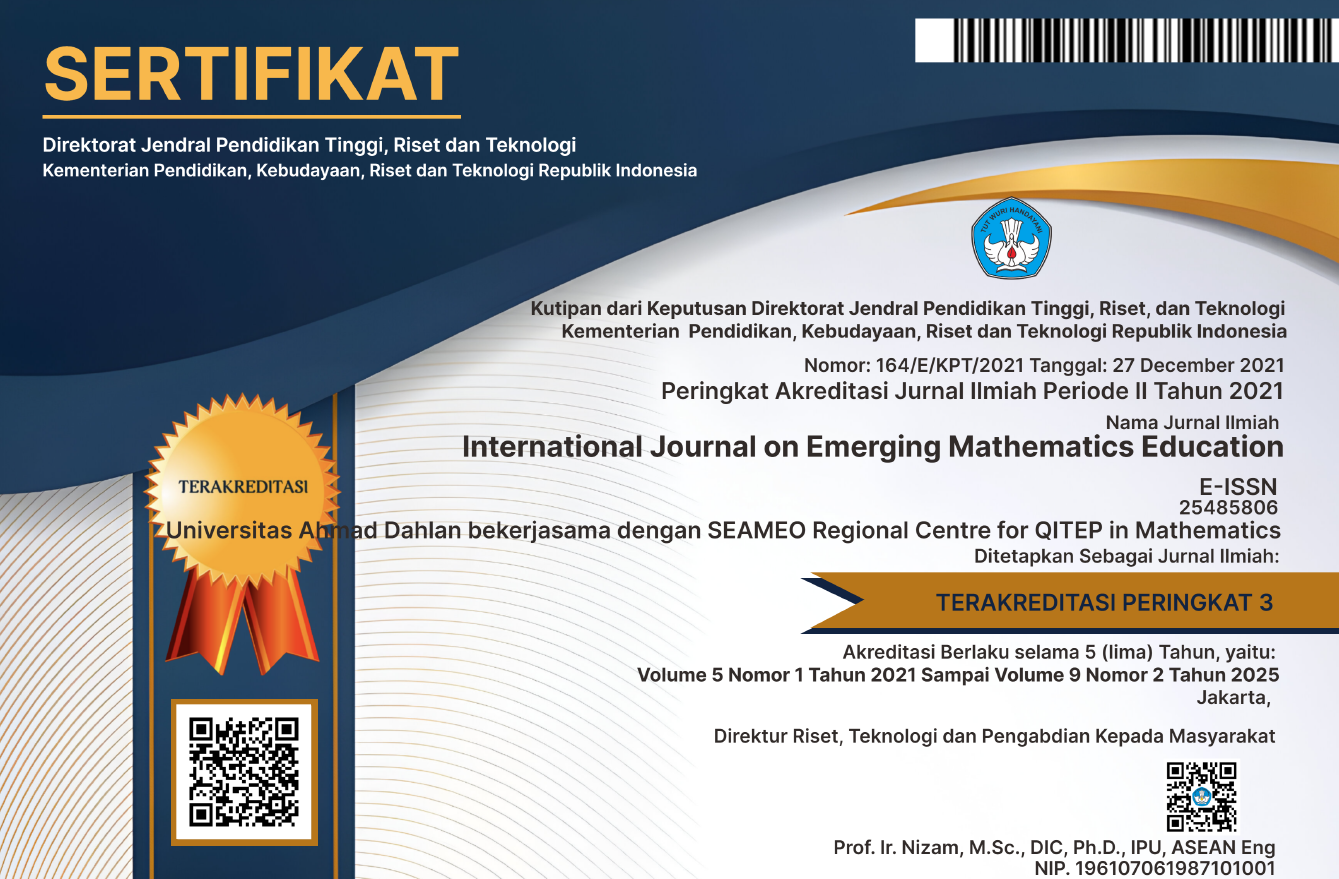Pre-Service Teachers’ Skills in Analyzing the Mathematics Competency Based on Bloom Taxonomy
DOI:
https://doi.org/10.12928/ijeme.v3i2.14549Keywords:
Bloom taxonomy, Competence achievement indicator, Curriculum analysis, Junior high school, Pre-service teacher, Professional teacher, School mathematics.Abstract
Professional teachers need to be skilled in planning their lesson. One of the activities to plan the lesson is analyzing the competence and teaching material demanded by the curriculum. This article aims to describe the Indonesian pre-service mathematics teachers’ skills in analyzing junior high school mathematics competence. The analysis is important to prepare the appropriate material for their students. This is qualitative research involving 26 pre-service teachers enrolled in the subject of Curriculum Analysis for Junior High School. First, they were assigned to analyze a given basic competence and were then challenged to select the appropriate materials and the indicators when the competence achieved according to Bloom taxonomy. Surprisingly, though there are many reference books available for sources of analysis, the teacher candidates found some difficulties in arranging the topics and composing the appropriate indicators. Some errors found such as the use of unmeasurable verbs, unclear activities, and illogical-irrelevant topics.References
Clements, D. H., Swaminathan, S., Hannibal, M. A., & Sarama, J. (1999). Young children’s concepts of shape. J. Res. Math. Educ., 30, 192–212.
Courey, S. J., Tappe, P., Siker, J., & LePage, P. (2013). Improved lesson planning with universal design for learning (UDL). Teacher Education and Special Education, 36(1), 7-27.
Dave, R. H. (1975). Developing and Writing Behavioral Objectives, R. J. Amstrong, ed., California: Educational Innovators Press.
Dyer, J., Gregersen, H., Christensen, C.M. (2011). The innovators’ DNA: Mastering the Five Skills of Disruptive Innovators. Boston: Harvard Business School Publishing.
Felder, R. M., & Brent, R. (2003). Designing and teaching courses to satisfy the ABET engineering criteria. Journal of Engineering Education, 92(1), 7-25.
Flevares, L. M., & Schiff, J. R. (2014). Learning mathematics in two dimensions: A review and look ahead at teaching and learning early childhood mathematics with children’s literature, Frontiers in Psychology, 5, 459.
Forehand, M. (2010). Bloom’s taxonomy. Emerging Perspectives on Learning, Teaching, and Technology, 41(4), 47-56.
Özgelen, S. (2012). Students’ science process skills within a cognitive domain framework. Eurasia Journal of Mathematics, Science & Technology Education, 8(4), 283-292.
MOEC. (2016). Peraturan Menteri Pendidikan dan Kebudayaan RI nomor 24 tahun 2016 tentang Kompetensi Inti dan Kompetensi Dasar pada Jenjang Pendidikan Dasar dan Menengah. Retrieved from: https://jdih.kemdikbud.go.id/arsip/Permendikbud_Tahun2016_Nomor024.zip.
Näsström, G. (2009). Interpretation of standards with Bloom’s revised taxonomy: a comparison of teachers and assessment experts. International Journal of Research & Method in Education, 32(1), 39-51.
Netti, S. & Nusantara, T. (2016). The Failure to Construct Proof Based on Assimilation and Accommodation Framework from Piaget. International Education Studies, 9(12), 12-22.
Pujiono, S. (2014). Kesiapan Guru Bahasa Indonesia SMP dalam Implementasi Kurikulum 2013. Litera, 13(2), 250-263.
Rahayu, G. D. S., & Firmansyah, D. (2019). Pengembangan pembelajaran inovatif berbasis pendampingan bagi guru sekolah dasar. Abdimas Siliwangi, 1(1), 17-25.
Sari, E. S. (2012). Online learning community: a case study of teacher professional development in Indonesia. Intercultural Education, 23(1), 63-72.
Taorina, R. M., Chandra, T. D., & Sisworo, S. (2018). Pengetahuan Calon Guru Matematika tentang Kurikulum 2013 dalam Penyusunan RPP. Jurnal Pendidikan: Teori, Penelitian, dan Pengembangan, 3(12), 1520-1529.
Thair, M., & Treagust, D. F. (2003). A brief history of a science teacher professional development initiative in Indonesia and the implications for centralised teacher development. International Journal of Educational Development, 23(2), 201-213.
Thompson, T. (2008). Mathematics teachers’ interpretation of higher-order thinking in Bloom’s taxonomy. International Electronic Journal of Mathematics Education, 3(2), 96-109.
Wilcox, R. (2017). Modern statistics for the social and behavioral sciences: A practical introduction. London: Chapman and Hall/CRC.
Zazkis, R., Liljedahl, P., & Sinclair, N. (2009). Lesson plays: Planning teaching versus teaching planning. For the Learning of Mathematics, 29(1), 40-47.
Downloads
Published
How to Cite
Issue
Section
License
License and Copyright Agreement
In submitting the manuscript to the journal, the authors certify that:
- They are authorized by their co-authors to enter into these arrangements.
- The work described has not been formally published before, except in the form of an abstract or as part of a published lecture, review, thesis, or overlay journal. Please also carefully read the International Journal on Emerging Mathematics Education (IJEME) Author Guidelines at http://journal.uad.ac.id/index.php/IJEME/about/submissions#authorGuidelines
- That it is not under consideration for publication elsewhere,
- That its publication has been approved by all the author(s) and by the responsible authorities, tacitly or explicitly, of the institutes where the work has been carried out.
- They secure the right to reproduce any material that has already been published or copyrighted elsewhere.
- They agree to the following license and copyright agreement.
Copyright
Authors who publish with the International Journal on Emerging Mathematics Education (IJEME) agree to the following terms:
- Authors retain copyright and grant the journal the right of first publication with the work simultaneously licensed under a Creative Commons Attribution License (CC BY-SA 4.0) that allows others to share the work with an acknowledgment of the work's authorship and initial publication in this journal.
- Authors are able to enter into separate, additional contractual arrangements for the non-exclusive distribution of the journal's published version of the work (e.g., post it to an institutional repository or publish it in a book), with an acknowledgment of its initial publication in this journal.
- Authors are permitted and encouraged to post their work online (e.g., in institutional repositories or on their website) prior to and during the submission process, as it can lead to productive exchanges, as well as earlier and greater citation of published work.
![]()
Ciptaan disebarluaskan di bawah Lisensi Creative Commons Atribusi-BerbagiSerupa 4.0 Internasional.




